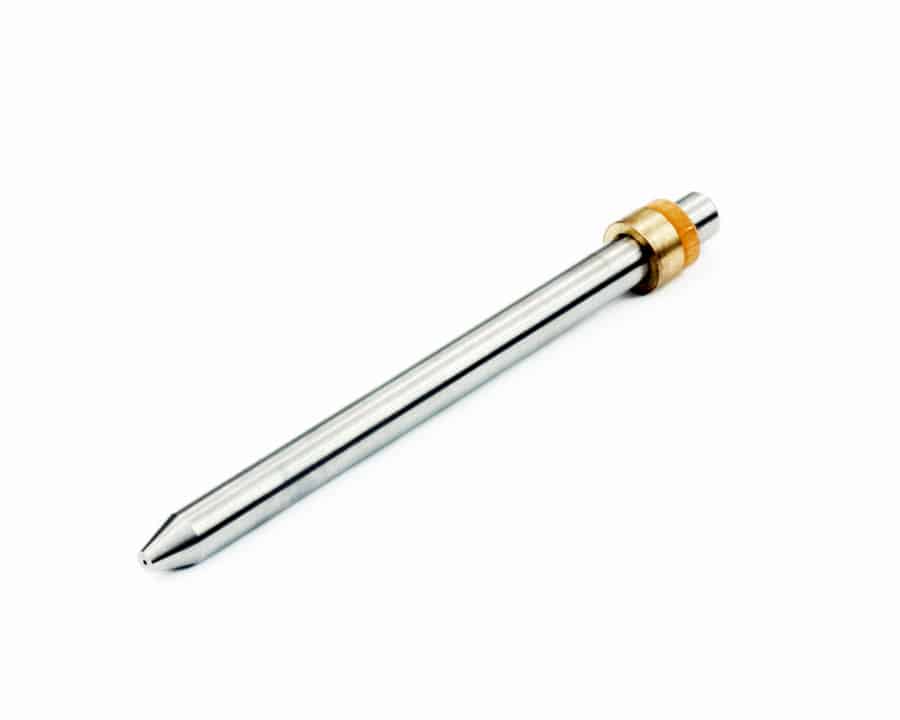A variety of techniques have been used to interrupt water jets. Many investigators examined phenomena related to fluctuating jets, either self-excited or with an external means for stimulating or driving the pulsation in the jet flow. As described by Nebeker, et al.,1970-1980, a pulsed water jet has advantages over conventional ones in water jet cutting and cleaning. By exerting an alternating force on the targets, the pulsed jet can produce high momentary pressure and subsequently generate high tensile stresses in the
impingement zone. This enhances unloading damage in the materials. There are several major kinds of devices which can generate the pulsed jets.
1. Percussive Jet:
The percussive jet (Fig. A.1) can be obtained by modulating the discharge of water through the jet nozzle, i.e., by cycling the discharge flow above and below its average value with some particular frequencies, amplitudes and wave forms. When this varying free flow strikes a target, the momentum flux through the nozzle is not transmitted as a steady force, but as a possibly discontinuous sequence of force peaks or percussive impacts.
- Impulsive Water Cannon:
In this case (Fig. A.2), the reciprocating movement of the piston generates the discontinuous flow. When the piston moves towards the right, it pushes the water out of the nozzle. Because the cross sectional area of the piston cylinder is much larger than that of nozzle, the high pressure in the cylinder can be transmitted into high kinetic energy of the flow at the nozzle exit. When the piston moves to the left, the water is supplied into the cylinder. By repeating the above cycle of the piston movement, the so called “water cannon” can be formed at the exit of the nozzle. The reciprocating time. of the piston is controlled to modulate the frequency of the pulsed jet for different drilling or cutting applications.
- Pulsed Jet Produced by Ultrasonic Vibration of the Nozzle:
A new concept for producing a discontinuous liquid jet is currently being developed by the use of ultrasonic axial nozzle vibration (Fig. A.3). An ultrasonic power generator is used in conjunction with a converter booster and horn in order to impose vibration on the nozzle. The high pressure water is induced into the horn and moved to the nozzle exit.
When the nozzle is moving in the same direction as the continuous jets, it increases the absolute jet velocity. While the nozzle moves in the opposite direction of the jet, it decreases the absolute jet velocity. As a result, the jets breaks into segments at the point where high velocity particles hit the slow moving ones. In this way, a pulsed jet flow is
generated. - The Fig. A.4 shows a pulsed jet produced by an oscillating piston installed upstream of the nozzle. At the initial stage, the steady flow enters the oscillating chamber. When the flow exits the oscillating chamber, the flow becomes the unsteady flow due to the vertically reciprocating movement of piston. Finally, the pulsed water flow is obtained at
the exit of the nozzle because of the periodic movement of the piston. - A pulsed flow can be produced by installation of an oscillating mechanical valve into the nozzle body (Fig. A.5). The periodic opening and closing of the valve is mechanically or electronically controlled. So, the steady flow at the entrance of the nozzle can become pulsing flow at the exit of the nozzle.
- Mechanical interruption of a continuous water jet can also be obtained by a perforated rotating disc (Fig. A.6). The perforated rotating disc is driven by a motor and placed downstream of the nozzle. During the process of fluid flow from upstream to the downstream of the nozzle, the jet passes the hole of the disc or impinges on the disc surface alternately and thus the pulsed jet formed.
- In the 1980’s, V.E. Johnson and A.F. Conn developed a concept of the self-resonating cavitating jet which can result in pulsation by modifying the geometry of the nozzle body. The operation of the self-resonating cavitating nozzle is based on the theory of fluid transients and hydro-acoustics. When the fluid flows all the way to the exit of nozzle, a kind of surge pressure is formed due to the change of the cross sectional area of the pipe. The surge pressure is then fed back to the inlet of the pipe and superimposed on the pressure pulses of the incoming flow to form a standing wave. If the frequency of the surge pressure matches the natural frequency of the flow, pressure resonance will occur and the jet is converted into a system of discrete ring vortices, leading to the inception of cavitation. The large vortices and strong oscillation make it possible to generate stronger cavitation and thus the erosion and cleaning action is enhanced.

